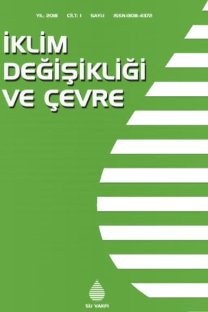Akuakültürde Tespit Edilen Fekal Koliform Kökenli Antimikrobiyal Direnç Genleri
Akuakültür, Antimikrobiyal Direnç Genleri, Enterobacter
___
- Agersø, Y., A. Petersen, (2006), The tetracycline resistance determinant Tet 39 and the sulphonamide resistance gene sulII are common among resistant Acinetobacter spp. isolated from integrated fish farms in Thailand. Journal of antimicrobial chemotherapy, 59(1), 23-27.Akinbowale, O., H. Peng, M. Barton (2007), P514 Class 1 integron mediates antibiotic resistance in Aeromonas spp. from rainbow trout farms in Australia. International Journal of Antimicrobial Agents, 29, S113.Aoki, T., S. Egusa, and T. Watanabe, (1973), Detection of R bacteria in cultured marine fish, yellowtails (Seriola quinqueradiata)., Jpn J Microbiol 17, 7–12.Bell, J. M., J. D. Turnidge, R. N. Jones (2003), Prevalence of extended-spectrum β-lactemse producing Enterobacter cloacea in the Asia-Pasific Region: results from the SENTRY Anti-microbial Survetllance Program, 1998-2001., Antimicrobial Agents Chemother,47, 3989-3993.Biendo, M, et al. (2008), Molecular typing and characterization of extended-spectrum TEM, SHV and CTX-M beta-lactamases in clinical isolates of Enterobacter cloacae, Res. Microbiol., 159, 590 –594.Castanheira, M., et al. (2011), Early dissemination of NDM-1- and OXA-181-producing Enterobacteriaceae in Indian hospitals: report from the SENTRY Antimicrobial Surveillance Program, 2006-2007, Antimicrob. Agents Chemother, 55, 1274 –1278.Chen, Y. H., et al. (2011), Antimicrobial susceptibility profiles of aerobic and facultative Gram-negative bacilli isolated from patients with intraabdominal infections in the Asia-Pacific region according to currently established susceptibility interpretive criteria., J. Infect., 62, 280 –291.Davidson, E. W., R. C. Rosell, and D. L. Hendrix (2000), Culturable bacteria associated with the whitefly, Bemisia argentifolii (Homoptera: aleyrodidae), Fla Entomol, 83, 159–171.Di Conza, J. A., G. O. Gutkind (2010), Integrones: los coleccionistas de genes. Revista argentina de microbiología, 42(1), 63-78.Hansen, G. N., J. Raa, and J. A. Olafsen (1990), Isolation of Enterobacter aglomerans from dolphin fish, Coryphaena hippurus L. J Fish Dis 13, 93–96.Su, H. C., G. G. Ying, R. Tao, R. Q. Zhang, L. R. Fogarty, & D. W. Kolpin (2011), Occurrence of antibiotic resistance and characterization of resistance genes and integrons in Enterobacteriaceae isolated from integrated fish farms in south China. Journal of Environmental Monitoring, 13(11), 3229-3236. Janssen, W.A. and Meyers, C.D., 1968, Fish: serologic evidence of infection with human pathogens, Science 159, 547–548.Kang, M. S., A. Kim, B. Y. Jung, M. Her, W. Jeong, Y. M. Cho, Y. K. Kwon (2010), Characterization of antimicrobial resistance of recent Salmonella enterica serovar Gallinarum isolates from chickens in South Korea. Avian pathology, 39(3), 201-205. Levesque, C., L. Piche, C. Larose and P. H. Roy, 1995, Antimicrob. Agents Chemother., 39, 185–191.Martinez, J. L. (2009), Environmental pollution by antibiotics and by antibiotic resistance determinants. Environmental pollution, 157(11), 2893-2902.McKinney, C. W., K. A. Loftin, M. T. Meyer, J. G. Davis, A. Pruden (2010), Tet and sul antibiotic resistance genes in livestock lagoons of various operation type, configuration, and antibiotic occurrence. Environmental science & technology, 44(16), 6102-6109.Neto, R.J., T. Yano, L.O.S. Beriam, S. A. L. Destefano, V. M. Oliveira, and Y. B. Rosato (2003), Comparative RFLP- ITS Analysis between Enterobacter cloacae strains isolated from plants and clinical origin., Arq Inst Biol, 70367–372.Nieto, T. P. and L. R. Lopez (1990), Isolation of Serratia plymuthica as an opportunistic pathogen in rainbow trout, Salmo gairdneri Richardson. J Fish Dis 13, 175–177.Pei, R., S. C. Kim, K. H. Carlson, A. Pruden (2006), Effect of river landscape on the sediment concentrations of antibiotics and corresponding antibiotic resistance genes (ARG). Water research, 40(12), 2427-2435.Roberts, M. C. (2005), Update on acquired tetracycline resistance genes. FEMS microbiology letters, 245(2), 195-203.Srinivasan, V., H. M. Nam, L. T. Nguyen, B. Tamilselvam, S. E. Murinda, S. P. Oliver (2005), Prevalence of antimicrobial resistance genes in Listeria monocytogenes isolated from dairy farms. Foodbourne Pathogens & Disease, 2(3), 201-211.Thillai Sekar, V., T. C. Santiago, K. K. Vijayan, S. V. Alavandi, V. Stalin Raj, J. J. S. Rajan, N. Kalaimani (2008), Involvement of Enterobacter cloacae in the mortality of the fish, Mugil cephalus. Letters in applied microbiology, 46(6), 667-672.Vigneulle, M., F. B. Laurencin (1995), Serratia liquefaciens: a case report in turbot (Scophthalmus maximus) cultured in floating cages in France. Aquaculture, 132(1-2), 121-124.
- ISSN: 1308-4372
- Başlangıç: 2008
- Yayıncı: Su Vakfı
Akarsuların Biyolojik Su Kalitesinin Belirlenmesinde Bentik Makroomurgasızların Kullanımı
Enis AKAY, Nurhayat DALKIRAN, Şükran DERE
Ceylanpınar Ovası’nda Yeraltı Suyu Tuzluluğunun Coğrafi Bilgi Sistemi Destekli İncelenmesi
Ayşegül DEMİR YETİŞ, Mehmet İrfan YEŞİLNACAR, Zeliha SELEK
Akuakültürde Tespit Edilen Fekal Koliform Kökenli Antimikrobiyal Direnç Genleri
Özcan YAVAŞ, Muhammed DUMAN, İzzet Burçin SATICIOĞLU, Ebru GARİP, Feza KARAER, Soner ALTUN
Sezar GÜLBAZ, Yunus KAYA, Cevza KAZEZYILMAZ ALHAN
Hava Kirliliğinin Kar Sularına Etkisi: Artvin İli Örneği
Serden BAŞAK, Kazım Onur DEMİRARSLAN
Yenilikçi Yönelim Analiz Yönteminin Logaritmik Eksende Değerlendirilmesi
Ergene Havzası 1990, 2000 ve 2012 Yılları Arazi Kullanım Değişikliklerinin Tespiti
